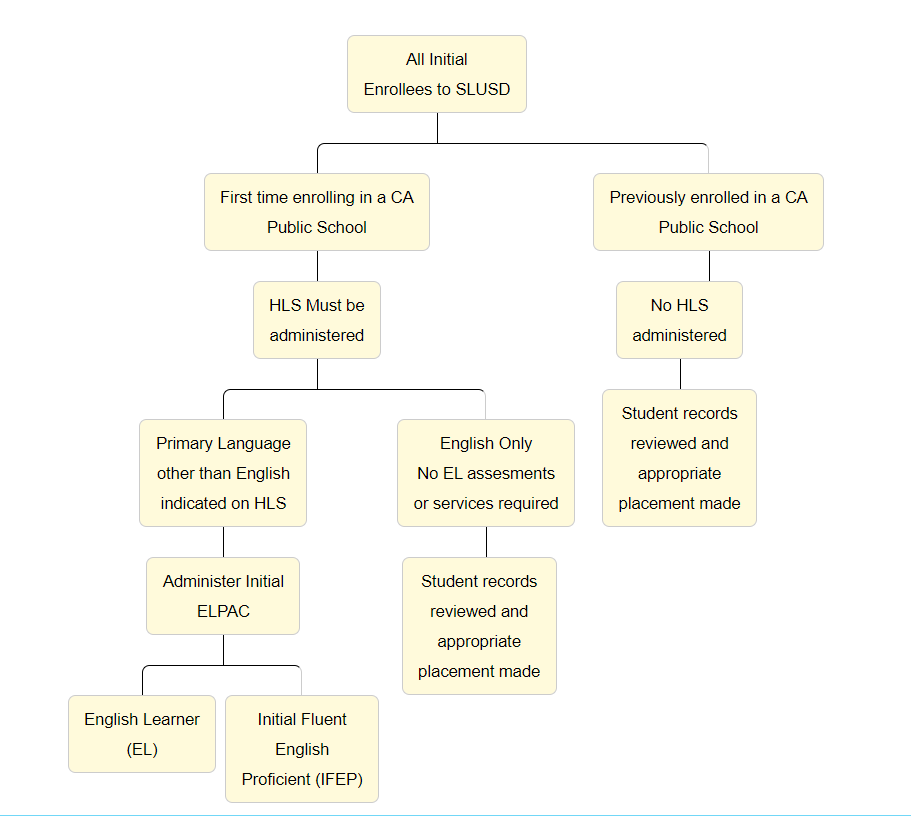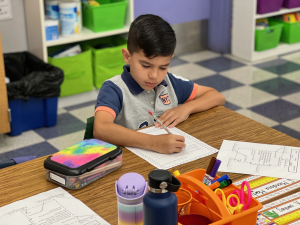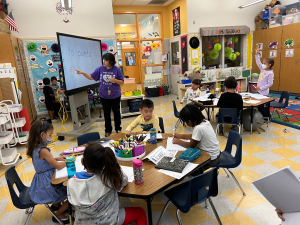INITIAL IDENTIFICATION, ASSESSMENT & PLACEMENT
San Leandro Unified School District is responsible for assessing and identifying students who have a primary language other than English to ensure we provide proper educational programming and support. This process starts with reviewing the Home Language Survey data provided by each family or legal guardian.
Identification
 The Home Language Survey (HLS)
The Home Language Survey (HLS)
When a parent or legal guardian enrolls their child in a California public school for the first time, they must complete a Home Language Survey (HLS) to determine the languages spoken at home by the student and family. This survey is completed online as part of the district’s centralized enrollment procedure.
If information is inaccurate on the HLS, the parent or guardian may request to change it only if the child has not already been assessed. The parent or guardian must contact the school site to complete a new HLS.
The information provided on the original HLS takes precedence over any subsequent HLS that may be completed after a student has been assessed or identified as an English learner.
The HLS consists of the following four questions:
- What language did this student learn when he or she first began to speak?
- What language do you use most frequently to speak to this student?
- What language does this student most frequently use at home?
- What is the language most often spoken by the adults at home?
If the answers to all four questions on the HLS are “English,” the child is identified as English Only and will not be assessed for English language proficiency. If the answers to any of the first three questions on the HLS indicate a language other than English, the district notifies the family that the child will be assessed using the Initial English Language Proficiency Assessments for California (IELPAC). The results of this assessment determine whether or not the student qualifies for placement in an EL program and requires EL services.
Initial Enrollment & Identification

Assessment
Initial English Language Proficiency Assessments For California (IELPAC)
The IELPAC is a criterion-referenced test based on the English Language Development (ELD) Standards that assess proficiency in listening, speaking, reading, and writing. For details, see the fact sheets from the California Department of Education for teachers and staff or families (English, Spanish). For Special Education students, the Individualized Education Plan (IEP) team may specify English proficiency be assessed using the Initial Alternate ELPAC.
Based on the overall performance on the IELPAC, students are designated as either an English Learner (EL) or an Initially Fluent English Proficient (IFEP) student. Students classified as IFEP are not eligible for English learner programs or services and are placed accordingly. Students identified as ELs are placed in an appropriate EL program and receive EL services. Students designated as EL are assessed annually using the Summative ELPAC until redesignated as Fluent English Proficient (RFEP). See Chapter 3 for more details.
Once Initial ELPAC results are available, the district notifies families in the Parent Notification Letter of the following:
- IELPAC score: Novice, Intermediate, or Fluent
- The student’s EL status (Novice or Intermediate) or IFEP (Fluent)
- Program Options
This process is completed within the first 30 days of the student’s first day of school (or as required by CDE.)
| California English Learner Continuum of Proficiency Levels | ||||||
|---|---|---|---|---|---|---|
| Summative ELPAC (Overall) |
Level 1 (Minimally Developed) |
Level 2 (Somewhat Developed) |
Level 3 (Moderately Developed) |
Level 4 (Well Developed) |
||
| Initial ELPAC | Novice | Intermediate | IFEP (Initially Proficient, Not EL) |
|||
| Proficiency Descriptors | Emerging | Expanding | Bridging | |||
Additional Assessments and Screeners
Sometimes additional assessments or screeners are needed to make decisions for appropriate placements.

Spanish Idea Proficiency Test (IPT)
Students enrolling in the Dual Language Immersion or Spanish Biliteracy programs with Spanish as primary language.
Initial Newcomer Screener
An informal intake interview at the school site is conducted with the parent or student with an interpreter, if necessary. Questions include information about prior schooling history.
Transfers From Other California Schools
Students transferring from another district within California should have a record of a Home Language Survey (HLS), scores on the mandated assessments, and language status in the state data system (CALPADS). These students do not need to undergo the district’s initial identification process. The information provided on the original HLS in CALPADS precedes any information provided on subsequent surveys.
Out Of State/Country Transfers
Students entering the district from another state or country are identified and assessed according to the district’s initial identification process. (See initial enrollment chart.) All relevant assessment, academic progress, and placement information will be entered into the Student Information System (AERIES) at the time of enrollment. The student is placed in the grade level aligned with the student’s age and/or transcripts. Schools review transcripts to determine the student’s prior placements and academic history. This same procedure applies to students transferring to California public schools from private schools for the first time.
Transfers Between SLUSD Schools
Parent-initiated intradistrict transfer requests are made through the centralized enrollment department. The centralized enrollment services personnel will notify the receiving school’s site of the transferring student so they can follow up with the family. The site is responsible for reviewing the information in AERIES (EL assessment history, current scores, current placement, records of academic progress, and interventions) to ensure the student is properly placed in an appropriate program at the new school.
Program Placement
The language acquisition programs offered by SLUSD schools are designed to meet the educational needs of English learners. As part of the initial enrollment process, families receive information about the instructional programs for English learners. (See Chapter 2).
| Elementary Programs | Secondary Programs |
|---|---|
|
|
 Students in all programs receive daily ELD instruction and parents/guardians of English learners may choose a language acquisition program that best suits their child. Families may opt-in or opt-out of a program for their student, and these decisions are made at the school site. However, families cannot opt-out of the state requirement that the official California assessment for English learners be administered yearly until the student is reclassified with fluent status.
Students in all programs receive daily ELD instruction and parents/guardians of English learners may choose a language acquisition program that best suits their child. Families may opt-in or opt-out of a program for their student, and these decisions are made at the school site. However, families cannot opt-out of the state requirement that the official California assessment for English learners be administered yearly until the student is reclassified with fluent status.
To the extent possible, any language acquisition program requested by the parents/guardians of 30 or more students at the school or by the parents/guardians of 20 or more students at any grade level shall be offered (ED Code 310.)
Considerations for Specific Groups
There is not one single EL profile in SLUSD, and we must be responsive to the various academic and social-emotional needs of each EL student. To best support the diverse needs of our students, we consider the various typologies of our EL students. It is important to identify specific characteristics of particular typologies to ensure proper placement (US Dept of Ed).
Newcomers
A newcomer in SLUSD is defined as a student born outside of the U.S. who is enrolled in a U.S. school for three years or less and is at an emerging level of English proficiency (Level 1 or 2 on the ELPAC). Identifying students is intended to help sites gather student information and assist with program placement and support. Programming for these students requires specialized, focused support as there is a commitment to the mastery of English and the acquisition of academic language while providing access to grade-level content learning. Students may be offered extended learning and enrichment opportunities including but not limited to: extended year/summer school, targeted counseling, mentoring, tutoring, primary language support, and adult school.
Characteristics of Newcomers include:
- May need support to access district proficiency exams due to English proficiency.
- Emerging level performance on state standardized tests when administered in English.
- May have experienced disruptions in their educations in their native countries; varied formal educational backgrounds.
- Literacy levels in native language vary.
Long-Term English Learners (LTEL)
LTELs are students who have been enrolled in U.S. schools for six years or more and are still classified as English learners. Students identified as LTELs may or may not be born in the U.S. These students often demonstrate proficiency in social English. Yet, for various reasons, they have not yet achieved or demonstrated levels of academic English proficiency. The district also identifies students enrolled in U.S. schools for four or five years as at risk of becoming LTELs.
Characteristics of Long-term English learners (LTELs) include:
- Enrolled in grades sixth through twelve.
- Enrolled for six or more years in U.S. schools.
- Have not met reclassification criteria.
- Remained at the same proficiency level for two or more years.
- May score at Standard Nearly Met (Level 2) or Standard Not Met (Level 1) on the English language arts state assessments.
- Often orally fluent in English, yet do not demonstrate proficiency in all domains (listening, speaking, reading, writing).
Characteristics of students at risk of becoming LTELs include:
- Enrolled in grades five to eleven.
- Enrolled for 4 or 5 years in U.S. schools.
- Score at the emerging or expanding levels on the ELPAC.
- Score in the fourth year at the Standard Nearly Met (Level 2) or Standard Not Met (Level 1) on the English language arts state assessment.
Students Identified For Special Education Services
When a student enrolls who has been identified to receive Special education services with a previously established Individualized Education Program (IEP), the same initial identification procedure for English learner services occurs. (See Enrollment Chart) If it is determined that a student must take the Initial ELPAC, important considerations must be made.
For students with specific learning disabilities, the IELPAC is administered with appropriate universal tools, designated supports, and accommodations. Any accommodations must be documented in the student’s IEP. (See California Accessibility Resources Matrix)
For students with the most significant cognitive disabilities, the Alternate IELPAC is used to identify possible EL status (assessment assignment determined by the student’s IEP team). All appropriate universal tools, designated supports, and accommodations must be selected and documented in the IEP. (See Initial Alternate ELPAC Fact Sheet)
If based on the results of the IELPAC or the Alternate IELPAC, if a student with an IEP is identified as an English learner, then the Special Education team must review the student’s IEP to determine that IEP goals and objectives are linguistically appropriate based on English language proficiency level. These dually identified students, regardless of their placement within Special Education programs, must receive ELD instruction and services, as do all ELs, in addition to the Special education services they require.



